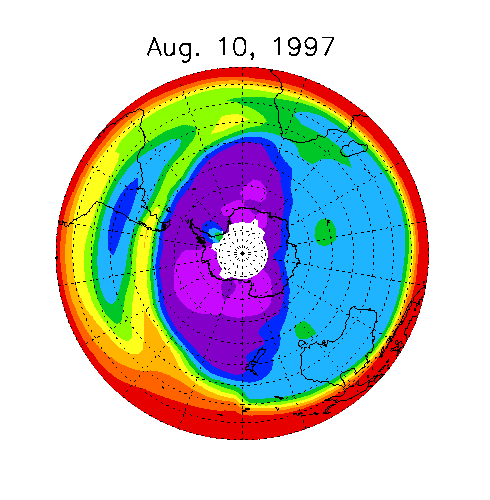
M.E.McIntyre
Centre for Atmospheric Science at the
Department of Applied Mathematics and Theoretical Physics
University of Cambridge
Article in Proc. IUTAM/IUGG/Royal Irish Academy Symposium on Advances in Mathematical Modelling of Atmosphere and Ocean Dynamics, held at the University of Limerick, Ireland, 2-7 July 2000, ed. P. F. Hodnett, Copyright © 2001 Kluwer Academic Publishers.
Geostrophic it's not,
But I don't care a lot,
'Cause it's all in a bit of a tangle.
The complete article, as finally sent to press in June 2001, can be downloaded as an acrobat (pdf) file (2.0Mb) from here, as an uncompressed postscript file (10.2 Mb) from here or as a gzipped postscript file (1.5 Mb) from here.

The above is an animated version of Figure 3b of the article, displaying CRISTA data, by kind courtesy of Dr Martin Riese of the research group at Wuppertal that developed the CRISTA instrument under the leadership of Professor Dirk Offermann. It shows the stratosphere's `gyroscopic pump' in action, slowly but persistently pulling air and greenhouse gases upward from the tropical lower atmosphere, and pushing them poleward and back downward (further animation and explanation in my lecture on dynamics significant for chemistry). This persistent circulation is called the Brewer-Dobson circulation, and its strength governs the rate at which man-made chlorofluorocarbons such as CFC11 and CFC12 are destroyed. The image is from paper no. 8179 published in J. Geophys. Res., 107(D23), pp. CRI 7-1 to CRI 7-13 (2002), entitled `Stratospheric transport by planetary wave mixing as observed during CRISTA-2'. To re-animate the image (necessary on some browsers), use the browser's reload button. The image shows the trace constituent nitrous oxide in the southern-hemispheric wintertime upper stratosphere over several days, at a pressure-altitude 10 hPa, about 30 km. Nitrous oxide (N2O, present in amounts ca. 10 to 102 molecules per billion air molecules) exhibits a large pole-to-equator gradient and provides an almost perfect passive tracer on timescales of days and weeks, characteristic of stratospheric Rossby waves and Rossby-wave breaking. Thus one can see the almost perfect mixing in large parts of the midlatitude `surf zone' (light blue area) and the steep gradients concentrated at its edges, indicating the reality of the inhomogeneous winter-stratospheric `wave-turbulence jigsaw puzzle'.
Why `waves' and why `breaking'? In brief, there are two giant waves travelling around the central, blue-purple area, which marks the stratospheric polar vortex. These are Rossby waves, also called vorticity waves. The wave dynamics depends on the Earth's rotation, constrained by the atmosphere's stable stratification. The wave breaking and turbulent mixing takes place mainly in the `surf zone' outside the central area. The dark blue streamer moving past New Zealand toward Australia can be thought of as analogous to the tip of a plunging ocean-beach breaker.
Justifying the analogy requires some familiarity with `wave-mean interaction theory', which goes back to Lord Rayleigh. The justification is given in a paper I published with Tim Palmer in 1985 (pdf file, 0.9Mbyte).
Not quite apropos -- more about certain turbulence theories:
Back to my home page ---- back to Atmospheric Dynamics home page